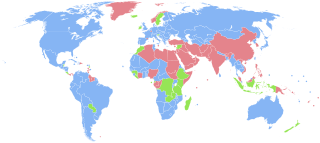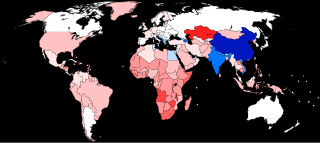Related Research Articles

The relationship between biology and sexual orientation is a subject of on-going research. While scientists do not know the exact cause of sexual orientation, they theorize that it is caused by a complex interplay of genetic, hormonal, and environmental influences. However, evidence is weak for hypotheses that the post-natal social environment impacts sexual orientation, especially for males.

Sex-selective abortion is the practice of terminating a pregnancy based upon the predicted sex of the infant. The selective abortion of female fetuses is most common where male children are valued over female children, especially in parts of East Asia and South Asia, as well as in the Caucasus, Western Balkans, and to a lesser extent North America. Based on the third National Family and Health Survey, results showed that if both partners, mother and father, or just the father, preferred male children, sex-selective abortion was more common. In cases where only the mother prefers sons, this is likely to result in sex-selective neglect in which the child is not likely to survive past infancy.
A natural experiment is a study in which individuals are exposed to the experimental and control conditions that are determined by nature or by other factors outside the control of the investigators. The process governing the exposures arguably resembles random assignment. Thus, natural experiments are observational studies and are not controlled in the traditional sense of a randomized experiment. Natural experiments are most useful when there has been a clearly defined exposure involving a well defined subpopulation such that changes in outcomes may be plausibly attributed to the exposure. In this sense, the difference between a natural experiment and a non-experimental observational study is that the former includes a comparison of conditions that pave the way for causal inference, but the latter does not.

A sex ratio is the ratio of males to females in a population. As explained by Fisher's principle, for evolutionary reasons this is typically about 1:1 in species which reproduce sexually. However, many species deviate from an even sex ratio, either periodically or permanently. Examples include parthenogenic species, periodically mating organisms such as aphids, some eusocial wasps, bees, ants, and termites.
Sociosexuality, sometimes called sociosexual orientation, is the individual difference in the willingness to engage in sexual activity outside of a committed relationship. Individuals who are more restricted sociosexually are less willing to engage in casual sex; they prefer greater love, commitment and emotional closeness before having sex with romantic partners. Individuals who are more unrestricted sociosexually are more willing to have casual sex and are more comfortable engaging in sex without love, commitment or closeness.
Birth order refers to the order a child is born in their family; first-born and second-born are examples. Birth order is often believed to have a profound and lasting effect on psychological development. This assertion has been repeatedly challenged. Recent research has consistently found that earlier born children score slightly higher on average on measures of intelligence, but has found zero, or almost zero, robust effect of birth order on personality. Nevertheless, the notion that birth-order significantly influences personality continues to have a strong presence in pop psychology and popular culture.

Human height or stature is the distance from the bottom of the feet to the top of the head in a human body, standing erect. It is measured using a stadiometer, in centimetres when using the metric system or SI system, or feet and inches when using United States customary units or the imperial system.

Physical attractiveness is the degree to which a person's physical features are considered aesthetically pleasing or beautiful. The term often implies sexual attractiveness or desirability, but can also be distinct from either. There are many factors which influence one person's attraction to another, with physical aspects being one of them. Physical attraction itself includes universal perceptions common to all human cultures such as facial symmetry, sociocultural dependent attributes, and personal preferences unique to a particular individual.

Parental investment, in evolutionary biology and evolutionary psychology, is any parental expenditure that benefits offspring. Parental investment may be performed by both males and females, females alone or males alone. Care can be provided at any stage of the offspring's life, from pre-natal to post-natal.

Fraternal birth order, also known as the older brother effect, has been correlated with male sexual orientation, with a significant volume of research finding that the more older brothers a male has from the same mother, the greater the probability he will have a homosexual orientation. Ray Blanchard and Anthony Bogaert first identified the association in the 1990s and named it the fraternal birth order effect. Scientists have attributed the effect to a prenatal biological mechanism, since the association is only present in men with older biological brothers, and not present among men with older step-brothers and adoptive brothers. The mechanism is thought to be a maternal immune response to male fetuses, whereby antibodies neutralize male Y-proteins thought to play a role in sexual differentiation during development. This would leave some regions of the brain associated with sexual orientation in the 'female typical' arrangement – or attracted to men. Biochemical evidence for this hypothesis was identified in 2017, finding mothers with a gay son, particularly those with older brothers, had heightened levels of antibodies to the NLGN4Y Y-protein than mothers with heterosexual sons.
In evolutionary biology and evolutionary psychology, the Trivers–Willard hypothesis, formally proposed by Robert Trivers and Dan Willard in 1973, suggests that female mammals adjust the sex ratio of offspring in response to maternal condition, so as to maximize their reproductive success (fitness). For example, it may predict greater parental investment in males by parents in "good conditions" and greater investment in females by parents in "poor conditions". The reasoning for this prediction is as follows: Assume that parents have information on the sex of their offspring and can influence their survival differentially. While selection pressures exist to maintain a 1:1 sex ratio, evolution will favor local deviations from this if one sex has a likely greater reproductive payoff than is usual.
Fisher's principle is an evolutionary model that explains why the sex ratio of most species that produce offspring through sexual reproduction is approximately 1:1 between males and females. A. W. F. Edwards has remarked that it is "probably the most celebrated argument in evolutionary biology".

The human sex ratio is the ratio of males to females in a population in the context of anthropology and demography. In humans, the natural sex ratio at birth is slightly biased towards the male sex. It is estimated to be about 1.05 or 1.06 or within a narrow range from 1.03 to 1.06 males per female.

The relationship between the environment and sexual orientation is a subject of research. In the study of sexual orientation, some researchers distinguish environmental influences from hormonal influences, while other researchers include biological influences such as prenatal hormones as part of environmental influences.

A micropenis is an unusually small penis. A common criterion is a dorsal penile length of at least 2.5 standard deviations smaller than the mean human penis size. A micropenis is stretched penile length equal to or less than 1.9 cm in term infants, and 9.3 cm in adults. The condition is usually recognized shortly after birth. The term is most often used medically when the rest of the penis, scrotum, and perineum are without ambiguity, such as hypospadias. A microphallus describes a medical term where other sections of genitallia are different, such as hypospadias or cryptorchidism. Micropenis incidence is about 1.5 in 10,000 male newborns in North America.
The child sex ratio in India is defined as the number of females per thousand males in the age group 0–6 years in a human population. Thus it is equal to 1000 x the reciprocal of the sex ratio in the same age group, i.e. under age seven. An imbalance in this age group will extend to older age groups in future years. Currently, the ratio of males to females is generally significantly greater than 1, i.e. there are more boys than girls.

The term "missing women" indicates a shortfall in the number of women relative to the expected number of women in a region or country. It is most often measured through male-to-female sex ratios, and is theorized to be caused by sex-selective abortions, female infanticide, and inadequate healthcare and nutrition for female children. It is argued that technologies that enable prenatal sex selection, which have been commercially available since the 1970s, are a large impetus for missing female children.

The hormonal theory of sexuality holds that, just as exposure to certain hormones plays a role in fetal sex differentiation, such exposure also influences the sexual orientation that emerges later in the individual. Prenatal hormones may be seen as the primary determinant of adult sexual orientation, or a co-factor with genes, biological factors and/or environmental and social conditions.
Female foeticide in India is the abortion of a female foetus outside of legal methods. A research by Pew Research Center based on Union government data indicates foeticide of at least 9 million females in the years 2000–2019. The research found that 86.7% of these foeticides were by Hindus, followed by Sikhs with 4.9%, and Muslims with 6.6%. The research also indicated an overall decline in preference for sons in the time period.
For years, the census data in China has recorded a significant imbalance sex ratio toward the male population, meaning there are fewer women than men. This phenomenon is sometimes referred to as the missing women or missing girls of China. China's official census report from 2000 shows that there were 117 boys for every 100 girls. The sex imbalance in some rural areas is even higher, at 130 boys to 100 girls, compared to a global average of 105 or 106 boys to 100 girls. In 2021, the male-to-female ratio of China is recorded at 104.61 to 100.
References
- 1 2 Kanazawa, S. (27 September 2007). "Big and tall soldiers are more likely to survive battle: a possible explanation for the 'returning soldier effect' on the secondary sex ratio". Human Reproduction. Vol. 22, no. 11. pp. 3002–3008. doi:10.1093/humrep/dem239 . Retrieved 25 December 2020.
- ↑ "Returning soldier effect". Jagiellonian University . Retrieved 25 December 2020.
- 1 2 Rutherford, Adam; Fry, Hannah (2 October 2023). "Introducing… Uncharted with Hannah Fry". The Curious Cases of Rutherford & Fry. BBC Radio 4 . Retrieved 24 February 2024.
- ↑ Davenport, Arthur Frederick (1901). "Notes on the Origin of Sex". Intercolonial Medical Congress of Australasia: Transactions of the Fifth Session, Held in Brisbane, Queensland, September 1899: 123–130. Retrieved 26 December 2020.
- ↑ MacMahon, Brian; Pugh, Thomas F (June 1954). "Sex ratio of white births in the United States during the Second World War". American Journal of Human Genetics. 6 (2): 284–292. PMC 1716540 . PMID 13158334.
- ↑ Allen, Laura (18 December 2008). "Why Does War Breed More Boys?". Popular Science. Retrieved 12 July 2023.
- ↑ Grant, Valerie J (2008). "Sex-of-Offspring Differences between Mothers". Evolutionary Psychology. 6 (1). doi: 10.1177/147470490800600117 . S2CID 146289598.
- ↑ Ridley, Matt (6 October 1994). The Red Queen: Sex and the Evolution of Human Nature. Penguin UK. ISBN 978-0-14-196545-1.
- ↑ James, William H (March 2009). "The variations of human sex ratio at birth during and after wars, and their potential explanations". Journal of Theoretical Biology. 257 (1): 116–23. Bibcode:2009JThBi.257..116J. doi:10.1016/j.jtbi.2008.09.028. PMID 18952111 . Retrieved 26 December 2020.
- ↑ Chao, Fengqing; Gerland, Patrick; Cook, Alex R.; Alkema, Leontine (7 May 2019). "Systematic assessment of the sex ratio at birth for all countries and estimation of national imbalances and regional reference levels". Proceedings of the National Academy of Sciences. 116 (19): 9303–9311. Bibcode:2019PNAS..116.9303C. doi: 10.1073/pnas.1812593116 . PMC 6511063 . PMID 30988199.